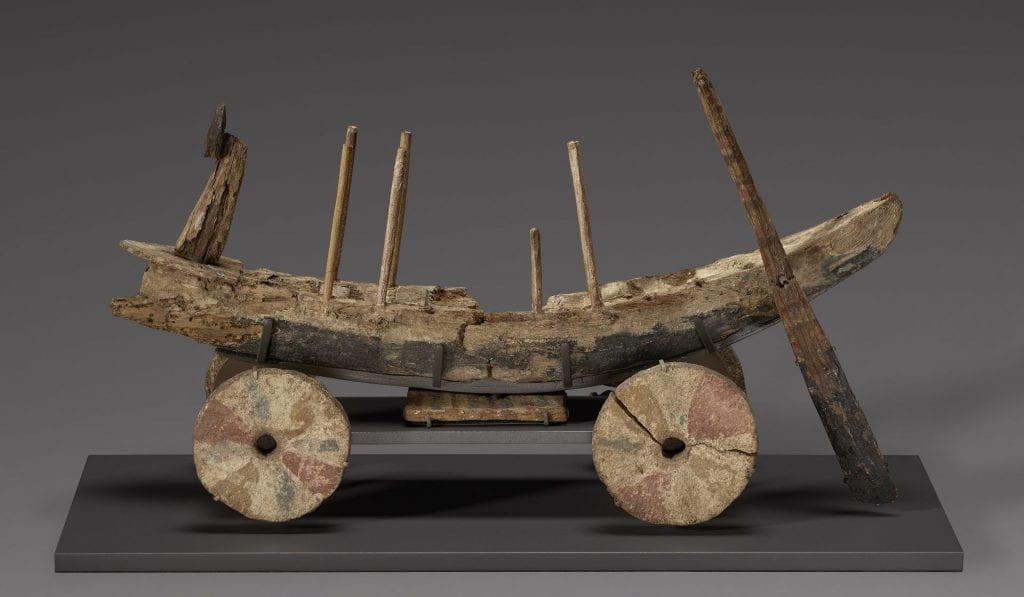From Gurob to the Getty: The Voyages of an Ancient Egyptian Ship-Cart Model
By Anna E Garnett, on 18 June 2019
‘Put simply, if Helen of Troy’s face launched a thousand ships, then at present the Gurob model is the nearest we can approach to that ship type’ (Shelley Wachsmann, 2018)
A new exhibition at the Petrie Museum explores the ancient and modern contexts of a unique object excavated from the site of Gurob in the Faiyum. In this exhibition, a Mycenaean-style painted wooden ship-cart model (UC16044) sits alongside a group of objects from the Petrie Museum collection that illustrate the story of the ancient inhabitants of Gurob. This unusual object has been the subject of much scholarly debate since its excavation.
In 1920, Flinders Petrie assigned two of his assistants, Guy Brunton and Reginald Engelbach, to work at Gurob. This work focused on the excavation of tombs at the site, which they believed still held promise in spite of continuing illicit excavations at that time. With their Egyptian workforce, Brunton and Engelbach found a remarkable painted wooden ship model and fragments of a wheeled cart in a tomb (no. 611). This was the only object found in the tomb, described on the tomb card simply as ‘Frags of painted wooden boat on wheels’.
During the New Kingdom (c. 1550-1069 BC), when the ship-cart model was made, an increase in royal military campaigns saw the Egyptian empire extend significantly across the Near East and south into Nubia (modern day Sudan). Merchants travelled to the Egyptian border to trade the products of their lands with Egypt. As a Mycenaean-style vessel deposited in a tomb in Egypt, this model tells an important story about the ancient migration of ideas and objects from the Greek mainland to Egypt during the Late Bronze Age.
The importance of this object lies in its highly unusual form and decoration: it appears to be a model of a ‘galley’ type of ship first used in Mycenaean Greece. The wheels on the cart show that the model, and the ship it represents, may have been intended to travel overland, possibly during ritual activity. As such, scholars have interpreted this model as a cultic object. However, when interpreting this object it is important to remember that there may have been differences between the model and the ship that remain to be established.

Digital Reconstruction of the ship-cart model by Prof. Shelley Wachsmann (Image courtesy of the Institute for the Visualisation of History)
Prof. Shelley Wachsmann (Texas A&M University) studied the ship-cart model in detail, producing a comprehensive publication of the model in 2013 and an associated online resource with 3D reconstructions. This important publication also includes the results of scientific analysis undertaken on the ship-cart model including pigment analysis, radiocarbon dating and wood identification. Wachsmann’s painstaking work on the digital reconstruction of the original form of the object helps to shed light on the functions of the different sections of the ship-cart, which was invaluable when the time came for the model to be conserved and reconstructed in 2018.
Due to its fragility and difficulties of displaying it, the ship-cart model has remained in storage for much of the time it has been part of the Petrie Museum collection. While well documented and accessible online, visitors were not able to enjoy the model on display. In 2018, it was loaned to the J. Paul Getty Museum in Los Angeles for their major exhibition ‘Beyond the Nile: Egypt and the Classical World’. Here the ship-cart model took centre stage as one of the most important objects in the exhibition.
Months of preparation went into making the ship-cart model ready for its journey across the Atlantic, including painstaking conservation by Philip Kevin and three weeks of dedicated work by Getty mountmaker Richard Hards to construct a bespoke mount for the object. Susi Pancaldo coordinated this work and accompanied the ship-cart model, and a group of other objects from the Petrie Museum, to the J. Paul Getty Museum. We are grateful that their skilled work and commitment means that we can now safely display the model at the Petrie Museum for visitors to enjoy.
‘From Gurob to the Getty: The Voyages of an Ancient Egyptian Ship-Cart Model’ is open at the Petrie Museum of Egyptian Archaeology, UCL, from June 18th – October 26th 2019.
Anna Garnett is the Curator of the Petrie Museum of Egyptian Archaeology, UCL.
 Close
Close




